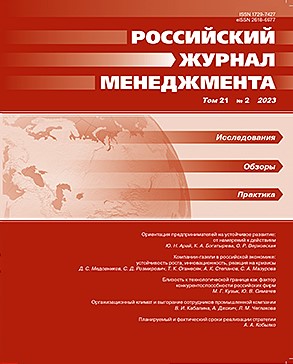Gazelle companies in the Russian economy: Innovation, steady rise, and crisis response
DOI:
https://doi.org/10.21638/spbu18.2023.202Abstract
Goal: verification of the most popular hypotheses found in the world academic literature on High Growth Companies (HGCs) using Russian empirical data and statistics.
Research methodology: desk research of publications; analysis of statistics from Ruslana, the database of Russian and Ukrainian companies (maintained by Bureau van Dijk — a Moody’s Analytics company) which contains financial indicators, tax reporting data, and other information; analysis of information from the Professional Market and Company Analysis System (SPARK) and Federal Institute of Industrial Property (Rospatent) databases on intellectual property ownership; and review of companies through formal questions in survey interviews.
Findings: this study demonstrates the key contribution of the HGCs sector to economic growth: HGCs, which represent 15 % of the total number of companies with revenues and more than 10 employees, generate 60 % of the revenue growth of all Russian companies and employment growth from 1.5 million to 2.5 million in 2017–2020. In the past, 77 % of HGCs grew sporadically, which does not support the hypothesis of unsustainable growth for most HGCs and can be the basis for using the rapid growth criterion for selective government support of business entities. There is evidence that innovative companies have more stable rates of rapid growth over the five-year period prior to this research. Based on the company survey, an assumption is formulated about the high resilience of Russian HGCs to external shocks including pandemic, Russia’s military operations, and sanctions against the country, and the HGCs’ willingness to continue growth despite existing difficulties and risks.
Originality and contribution of the authors: for the first time in Russia, this study analyzes the full set of Russian HGCs using a comprehensive statistical database. This allows us to compare HGCs from different industries and identify their industry-specific characteristics. In addition, we identify a group of innovative HGCs and show the characteristics of this type of companies. The materials obtained as a result of the review of companies supplement the results of the analysis of statistical data.
Keywords:
high growth companies, gazelles, innovation, coronavirus pandemic, sanctions against Russia, economic growth, rapid growth, sustainable growth
Downloads
References
Гохберг Л.М., Куценко Е.С., Тюрчев К.С. и др. Китайский учет технологических компаний. ИСИЭЗ ВШЭ. 30.09.2022. URL: https://issek.hse.ru/news/777789378.html (дата обращения: 03.10.2022)
Ермилова Ю. 2020. Омбудсмен Наталья Попова: миссия — помочь инновационным компаниям одолеть "долину смерти" ТАСС 23.03.2020. URL: https://tass.ru/interviews/8040237 (дата обращения: 07.07.2022);
Марьина А. 2021. Власти предложили увеличить предельные значения дохода для компаний малого и среднего бизнеса: что они не учли. Сетевое издание RB.RU 25.08.2021. URL: https://rb.ru/story/msb-revenue/ (дата обращения: 07.07.2022)
Медовников Д.С., Розмирович С.Д., Оганесян Т.К. и др. 2022. Российские быстрорастущие компании: размер популяции, инновационность, отношение к господдержке / Под общ. ред.: Д.С. Медовников, С.Д. Розмирович. Вып. 2: Аналитические доклады Высшей школы бизнеса ВШЭ. М.: Издательский дом НИУ ВШЭ, 2022.
Петрова В. Сумма технологиям. Коммерсант 163 (06.09.2022). URL: https://www.kommersant.ru/doc/5547507 (дата обращения: 07.09.2022)
Anyadike-Danes M., Bonner K., Hart M., Mason C. 2009. Measuring Business Growth: High-growth firms and their contribution to employment in the UK. NESTA - National Endowment for Science, Technology and the Arts
Banno M., Varum C.A. 2021. Champions during Crises Scenarios: High Growth and Persistent High Growth Firms. Research in Applied Economics 13 (2).
Benedetti Fasil, C., Del Rio, J.C., Domnick, C., Fako, P., Flachenecker, F., Gavigan, J., Janiri, M., Stamenov, B. and Testa, G., High Growth Enterprises in the COVID-19 Crisis Context. Technical report by the Joint Research Centre (JRC), the European Commission’s science and knowledge service. Publications Office of the European Union, Luxembourg.
Birch D.L. 1981. Who creates jobs? The Public Interest. 65 (Fall).
Coad A., Rao R. 2008. Innovation and firm growth in high-tech sectors: a quantile regression approach. Res. Policy 37(4).
Daunfeldt S.-O., Halvarsson D. 2015. Are high-growth firms one-hit wonders? Evidence from Sweden. Small Business Economics 44 (2).
Eurostat. 2007. OECD Manual on Business Demography Statistics. URL: https://www.oecd.org/sdd/business-stats/eurostat-oecdmanualonbusinessdemographystatistics.htm
Grillitsch M., Schubert T., Srholec M. 2019. Knowledge base combinations and firm growth. Research Policy 48 (1): 234-247.
Grover Goswami A., Medvedev D., Olafsen E. 2019. High-Growth Firms: Facts, Fiction, and Policy Options for Emerging Economies. Washington, DC: World Bank. URL: https://openknowledge.worldbank.org/handle/10986/30800
Henrekson M., Johansson D. 2010. Gazelles as job creators: a survey and interpretation of the evidence. Small Business Economics 35 (2).
Mason G., Bishop K., Robinson C. 2009. Business Growth and Innovation: The wider impact of rapidly-growing firms in UK city-regions. NESTA - National Endowment for Science, Technology and the Arts
NESTA. 2009. The vital 6 per cent - How high-growth innovative businesses generate prosperity and jobs (Research Summary)
OECD. 2010. High-Growth Enterprises: What Governments Can Do to Make a Difference. OECD Studies on SMEs and Entrepreneurship - OECD Publishing
OECD. 2021. Understanding Firm Growth. Helping SMEs Scale Up.
Schepers J. et al. 2021. The Impact of the COVID-19 Crisis on Growth-Oriented SMEs: Building Entrepreneurial Resilience. Sustainability 13.
Downloads
Published
How to Cite
Issue
Section
License
Articles of the Russian Management Journal are open access distributed under the terms of the License Agreement with Saint Petersburg State University, which permits to the authors unrestricted distribution and self-archiving free of charge.





